Best Shoes for the Camino de Santiago (& Mistakes to Avoid)
Finding the best shoes for the Camino de Santiago can feel overwhelming. You’ll be walking for hours every day—and choosing the wrong pair could even compromise your pilgrimage.
I found that out the hard way. By day three of my first Camino, my feet were covered in blisters and in so much pain that I was terrified I’d have to quit. Thankfully, I bought a new pair of shoes along the way that have since become my go-to shoe for all my Caminos!
While there’s no one perfect shoe for everyone (we all have different feet, after all), I’ll share what worked for me, what’s worked for other pilgrims (based on my poll of almost 300), and how to find the pair that’s right for you.
Keep reading to learn the exact shoe that saved my Camino, plus 13 more top-rated options and tips for avoiding the mistakes I made.

Best Camino Footwear at a Glance
If you're in a rush and don't have time to read this full article, here's a quick list of my top footwear recommendations to consider for the Camino de Santiago:
- Best for Maximum Cushioning: Hoka Speedgoat
- Best for Wide Feet + Zero-Drop Stability: Altra Lone Peak
- Best for More Durability: Merrell Moab Hiking Shoes
- Most Eco-Friendly: Brooks Cascadia
While these are some of the best footwear options, make sure to find the shoe that's right for you! We all have different feet, and you'll likely want to try several different shoes to find whichever works best for your feet.
What Type of Shoe is Best for Walking the Camino?
People walk the Camino in all kinds of shoes: hiking boots, trail runners, hiking sandals. Heck, a rare person even goes barefoot, but that's not recommended for obvious reasons.
The general consensus is that trail running shoes are best for the Camino. They provide the most comfort and breathability for your feet while still giving you good traction on any potentially slippery or steep surfaces. Plus, they're much lighter and easier to walk in.
Some people choose hiking boots for the ankle support–that's what I originally did, but those were the shoes that gave me all kinds of issues. Generally if you're hiking one of the most popular routes like the Camino Francés or Portugués, you don't need to worry much about added ankle support that boots would give.
While there's some elevation gain and loss on those routes–more so on the Francés–much of the way is on fairly flat and even surfaces making boots largely unnecessary.
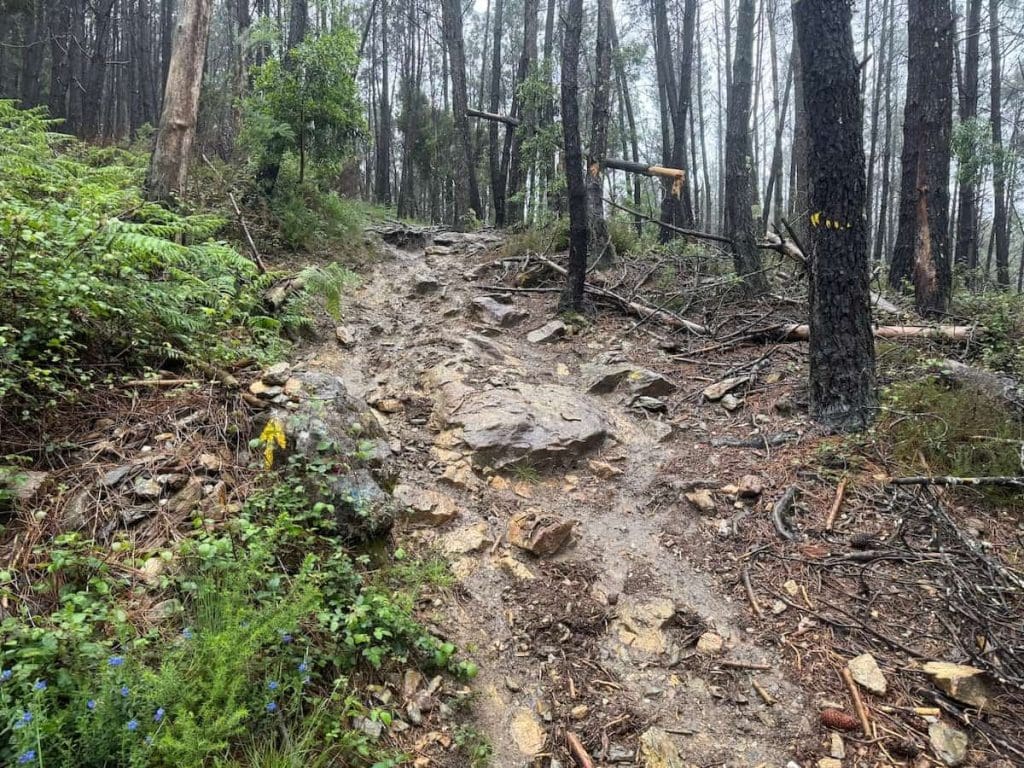
However, if you're doing one of the more mountainous routes like the Norte or the Primitivo, you may want to consider boots for the extra ankle support, especially if you've had ankle issues in the past.
On the other end of the Spectrum, some pilgrims choose to walk in regular running shoes. While those are ok for large sections of the Camino routes, they won't give your feet much traction or protection while hiking through rougher terrain.
Even on the least strenuous of the Camino routes–the Portuguese Way–you'll encounter rocky inclines and declines where it's beneficial to have a shoe with more traction.
Trail running shoes are the perfect in-between. They provide good grip and protection from rocks and sticks like hiking boots while being more lightweight and breathable like running shoes.
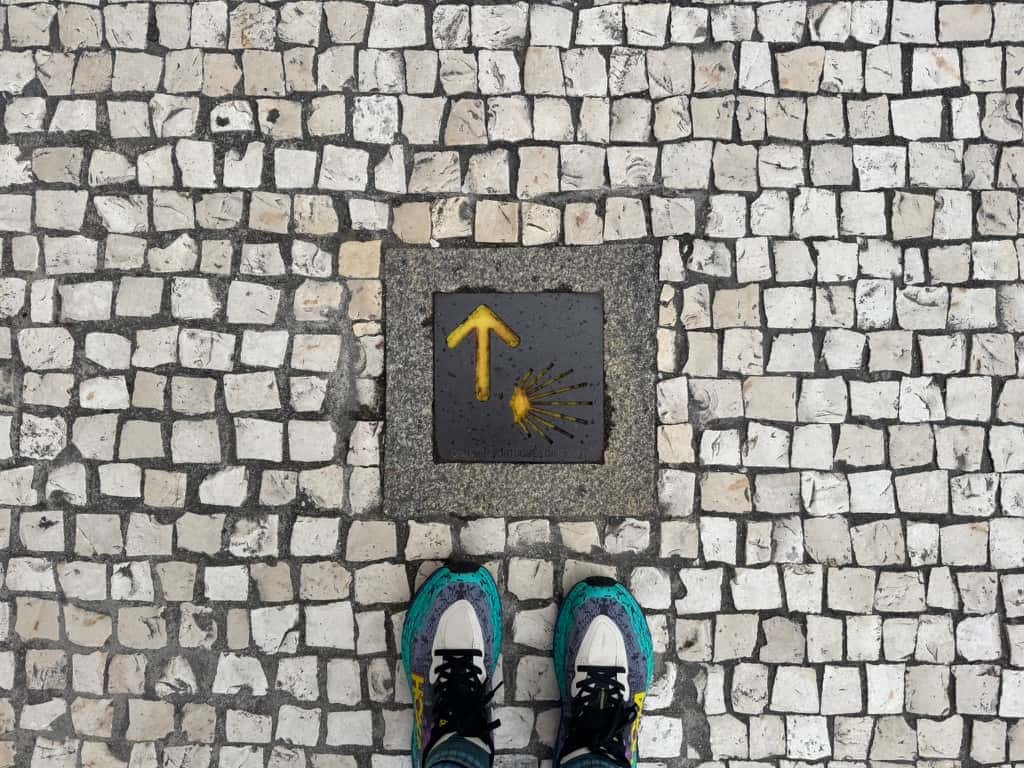
What to Look for in a Trail Running Shoe for the Camino
Ok so you want to get a trail shoe now, but how do you choose? There are so many different kinds out there built for varying kinds of trails and focusing on different features.
As you get ready for your Camino and think about what kind of shoe would be best for you, here are a few factors that I find are most important to consider:
- Cushion: Do you prefer a shoe that provides more cushioning or one that gives you a better feel for the ground below your feet? Some people like extra cushioning when walking long distances, but some people find that they don't feel steady on their feet when there's a lot of cushioning.
- Width: Some shoes run narrower or wider than others. Generally you want a bit more space in your shoe as your feet will likely swell on the Camino.
- Heel-to-toe drop: Most shoes have a similar drop, but there are some popular models with low-to-zero heel-to-toe-drop. Those kinds of shoes simulate a more natural stride as if you were walking barefoot, but they take some time to get used to and aren't for everyone.
- Grip: Generally any trail shoe should have a fine enough grip for most Camino routes. However, if you're doing a more rugged trail like the Norte or Primitivo you'll want to make sure you find a pair with a stronger grip.
- Durability: Especially if you're planning to walk for several weeks or more, you want to make sure you have a shoe that will be up for the distance and won't fall apart.
- Ability to dry quickly: You'll want a shoe that can dry fairly quickly if it gets wet. That's one reason why I recommend avoiding Gore-Tex waterproof shoes (more on that in the mistakes section below).
- Weight: When walking such long distances day after day, you'll want to have a lightweight shoe.
- General fit: Ultimately, your shoe of choice will largely come down to what feels best to you. Try on several different pairs and see what your feet like the most. It's one thing to read about the features here but another to actually try the shoes out for yourself.
Keep in mind that you don't need a shoe built for extremely rugged conditions for the Camino, so that's something to help you narrow down your search too. That said, if you think you might use the shoe later for more rugged hiking, it's ok to get one made for that if it's what's most comfortable for you.
Top Trail Running Shoes for the Camino
Here are some of the best trail shoes for the Camino de Santiago based on reviews from those who have walked the pilgrimage.

Hoka Speedgoat Trail Running Shoes: My Go-To Camino Shoe!
Hoka Speedgoat trail running shoes are my go-to shoe for the Camino de Santiago. These are the shoes I bought during my hike on the Camino Francés in 2023 when my hiking boots were absolutely killing my feet.
I decided to buy Hokas for a few reasons:
- I'm also a marathon runner and Hokas are my go-to shoe for running. I've found them to be the absolute best shoes for my feet and to provide the most cushioning. Since I trusted them for running, I figured my feet would like them for the Camino as well.
- It seemed like on my Camino Francés almost everyone around me was wearing Hoka Speedgoats, so that was a good sign for me as well. My recent poll of pilgrims confirmed they're still super popular as they tied for the #1 most worn shoe.
Even though I didn't break them in before wearing them on the Camino, my feet still felt an immediate relief. I stopped getting blisters once I put them on, and my feet felt so much more comfortable.
Aside from comfort, these shoes are lightweight, breathable, and provide a strong grip. I found the durability great too. I bought them several days into my Camino Francés and they lasted 346 miles (556 km) with life still left in them when I finished.
I had such a good experience with Hoka Speedgoats on the Camino that I bought another pair for my Portuguese Way hikes along the Central route and Coastal route in 2025. My feet felt great on both of those Caminos too, and I didn't have any issues with the shoes at all!
I've written a more detailed review on these shoes so check that out if you want more information.
Buy Hoka Speedgoat Trail Shoes
Check out my go-to shoes for the Camino:
➡️ Buy from REI: Women's ($124.93+) | Men's ($155.00)

13 Other Popular Trail Shoes for the Camino
I got lucky finding a go-to shoe so quickly, so I haven't tried any other shoes for the Camino myself. However, I polled 277 other pilgrims and spent hours looking through Camino Facebook groups, forums, and product reviews to find out other top Camino de Santiago shoe recommendations for you to check out.
Here are some of the other best shoes for the Camino de Santiago ranked in order of popularity.
1. Altra Lone Peak
Altra Lone Peaks are one of the most popular trail running shoes available in general as well as on the Camino. People like them for their wide toe box, natural feeling with the zero drop, and light weight.
They tied the Speedgoats for the #1 shoe of choice among the pilgrims I polled.
They have a moderate amount of cushioning that still allows you to feel the ground below. There's a rock plate for extra protection against rugged terrain and people say they're flexible and breathable.
Note that walking in a shoe with a zero drop heel–meaning it's completely flat instead of having a slightly elevated heel like most shoes–can take some getting used to. If you've never tried zero drop shoes before, take extra time testing them out since they're so different.
Buy Altra Lone Peak Trail Shoes
➡️ From REI: Women's ($140.00) | Men's ($140.00)
➡️ From Amazon: Women's ($113.62+) | Men's ($109.95+)
2. Altra Olympus
Another highly popular shoe from Altra, the Olympus has more cushioning and grip than the Lone Peak. Like the Lone Peak, this model has a wide toe box, zero drop, and lightweight design.
As noted above, if you've never tried a zero drop shoe before, definitely take more time trying out these shoes to see if your body adapts and if you like them.
In my poll, 18 pilgrims (6.5%) said this is their favorite shoe for the Camino.
Buy Altra Olympus Trail Shoes
➡️ From REI: Women's ($175.00) | Men's ($175.00)
➡️ From Amazon: Women's ($173.20+) | Men's ($121.00)
3. Merrell Moab Hiking Shoes
The Merrell Moab is technically a hiking shoe and not a trail running shoe. However, it's SO popular, I had to include it in this list!
As a hiking shoe, these a bit tougher–more like a hiking boot but without the ankle support.
With that in mind, these shoes are heavier but provide more support and durability. If you want something that's more in between a hiking boot and a trail running shoe, these could be a good option for you to try out.
These shoes tied the Altra Olympus in my poll with 6.5% of respondents naming this their favorite shoe.
Buy Merrell Moab Hiking Shoes
➡️ From REI: Women's ($120.00+) | Men's ($120.00+)
➡️ From Amazon: Women's ($80.60+) | Men's ($81.54+)
4. Topo Athletic Terraventure
The Topo Athletic Terraventure shoes are designed to handle rough terrain with their rockplate and strong grip. They have a low drop at 3 millimeters and are often compared to the Altra Lone Peak.
The shoes have a moderate amount of cushioning and roomy toe boxes. People say they're breathable and comfortable right out of the box.
14 poll respondents (5.05%) said this is their favorite Camino shoe.
Buy Topo Athletic Terraventure Trail Shoes
➡️ From REI: Women's ($140.00) | Men's ($140.00)
➡️ From Amazon: Women's ($139.95+) | Men's ($139.95+)
5. Salomon XA Pro 3D
Salomon makes some of the best trail running shoes, and they're quite popular on the Camino.
The Salomon XA Pro 3D shoes are known to have good cushioning, durability, and stability. They are a little heavier and apparently tend to need a bit more time to break in, so keep that in mind if you try them out.
The uppers in these shoes–meaning the sides and the top area of the shoe–are made with 35% recycled materials.
13 poll respondents (4.69%) named this their favorite shoe.
Buy Salomon XA Pro 3D Trail Shoes
➡️ From REI: Women's ($140.00) | Men's ($140.00+)
➡️ From Amazon: Women's ($109.99+) | Men's ($140.00+)
Connect with Other Women Hiking the Camino
Join my free Facebook group! We're building up a community of women who have hiked or are planning to hike the Camino there. You can also get personalized support from me!
6. Brooks Cascadia
Another popular option, Brooks Cascadia are known for their strong grip, big toe box, and good fit for many people. These shoes are a little heavier than some other trail shoes, but they're still lighter than hiking boots.
They have a rock plate to reduce discomfort from rocky surfaces you step on, and there's a moderate amount of cushion. They're known to dry quickly too.
Plus, these shoes are a bit more eco-friendly, as they're made with recycled materials. They also use 66% less energy and 75% water in their dying process than is typical.
11 poll respondents (3.97%) said this is their favorite shoe for the Camino.
Buy Brooks Cascadia Trail Shoes
➡️ From REI: Women's ($110.93) | Men's ($110.93)
➡️ From Amazon: Women's ($109.95+) | Men's ($109.95+)
7. Hoka Challenger
The Hoka Challenger is not quite as grippy as their Speedgoat counterpart. However, they still provide good traction, especially on the Camino where you won't be on technical trails very often.
In fact, these shoes were designed to handle a variety of surfaces like roads and fairly gentle trails, exactly the kind of surfaces you'll find on most Camino routes.
Compared to the Speedgoats, the Challenger has more cushioning and a little bit more flexibility.
If you're interested in Hokas, it's definitely worth trying both models and seeing which feels better on your foot.
8 poll respondents (2.89%) said this is their favorite shoe for the Camino.
Buy Hoka Challenger Trail Shoes
➡️ From REI: Women's ($155.00) | Men's ($155.00)
8. Salomon Speedcross
The Speedcross is another popular model from Salomon. This shoe was specifically designed to handle muddy terrain so could be a good option if you'll be walking during a rainy time of year or on one of the rainier routes like the Norte.
These shoes don't have a rock plate and they offer a moderate amount of cushioning but less so than some of the other models on this list. This is because they were really designed for soft muddy surfaces.
They have a higher heel-to-toe drop at 10 millimeters, meaning they'll encourage your heel to strike the ground first when stepping.
I actually tried these shoes myself back in 2021 when I was training for an ultramarathon. I really liked them except for some reason while wearing an ankle brace, they hurt the arch on that foot.
7 poll respondents (2.53%) said this is their favorite Camino shoe.
Buy Salomon Speedcross Trail Shoes
➡️ From REI: Women's ($145.00) | Men's ($145.00)
➡️ From Amazon: Women's ($101.24+) | Men's ($116.00+)
9. Topo Athletic MTN Racer
The MTN Racer from Topo Athletic has thicker cushioning and a wider fit than the Terraventure. The shoe has more of a moderate heel-to-toe drop. It's a lightweight shoe with a roomy toe box, strong grip, and breathable upper.
5 poll respondents (1.81%) said this is their favorite shoe for the Camino.
Buy Topo Athletic MTN Racer Trail Shoes
➡️ From REI: Women's ($155.00) | Men's ($155.00)
➡️ From Amazon: Women's ($154.95+) | Men's ($154.95+)
10. Saucony Peregrine
A lot of pilgrims love the Saucony Peregrine shoes. They have a lower drop than a lot of other shoes at 4 millimeters, are fairly light, and are breathable.
The Saucony Peregrine has moderate cushioning and a forefront rock guard. Reviewers say they feel pretty cushiony and are quite comfortable.
Earlier this year, Runner's World–a top running publication–named these shoes the best trail running shoe.
Some people report bad durability with these shoes, but plenty of people don't have any issues. Maybe consider making sure you can return the shoes to the store or get them replaced by a warranty in case you have any durability problems.
4 poll respondents (1.44%) named this their favorite Camino shoe.
Buy Saucony Peregrine Trail Shoes
➡️ From REI: Women's ($145.00) | Men's ($145.00)
➡️ From Amazon: Women's ($139.95+) | Men's ($119.98+)
11. Merrell Moab Speed
These shoes from Merrell are much lighter but still have more cushioning, good grip, and solid stability.
Compared to the Moabs, they look more like a trail runner in design and less like a hiking boot. They're one of the most beautiful hiking/trail shoes when it comes to design that I've seen.
Reviewers say they're comfortable on all kinds of terrain from roads to rugged trails. They say they're durable and dry fairly quickly.
Parts of the shoe are made from recycled materials.
4 poll respondents (1.44%) said this is their favorite Camino shoe.
Buy Merrell Moab Speed Hiking Shoes
➡️ From REI: Women's ($140.00) | Men's ($140.00)
➡️ From Amazon: Women's ($82.88+) | Men's ($140.00+)
12. Brooks Caldera
Compared to the Cascadia, the Brooks Caldera offers a much more cushioned shoe. They have good ventilation and are pretty stable shoes.
Run, by Outside Magazine, named this the best max cushioned trail running shoe. Even with its cushioning, Run's testers found that they still had a good ground feel of rough terrain.
The Brooks Caledera shoes aren't the lightest on this list, but they're a popular Camino shoe nonetheless. One person polled did report that the cushion in their shoes deteriorated in the middle of their Camino Francés so they had to buy a new pair.
Just 3 poll respondents (1.08%) named this their favorite shoe for the Camino. However, this shoe also comes up in other forums and Facebook groups, which is why I've included it here.
Buy Brooks Caldera Trail Shoes
➡️ From REI: Women's ($150.00) | Men's ($150.00)
➡️ From Amazon: Women's ($149.95+) | Men's ($149.95+)
13. La Sportiva Bushido
Some pilgrims swear by La Sportiva trail running shoes. The Bushido is one of the most popular models and is known for giving a good grip and stability.
They have a moderate amount of cushioning and a rock plate to protect your feet from rugged terrain.
La Sportiva recommends buying their shoes in a half size larger than your usual because they use European half sizes, which means they run smaller. These shoes are also known to be more narrow, so if you have a wider foot, these may not work for you.
Just 2 poll respondents (0.72%) named this their favorite shoe for the Camino. However, this shoe comes up in other forums and Facebook groups, so that's why I've included it here.
Buy La Sportiva Bushido Trail Shoes
➡️ From REI: Women's ($145.00+) | Men's ($145.00+)
➡️ From Amazon: Women's ($123.21+) | Men's ($145.00+)
Don't Make These Mistakes When Choosing Your Hiking Shoes
When choosing your walking shoes, there are a few mistakes you'll want to avoid making that will help maximize your success with a pair of shoes on the trail. Keep these in mind once you decide which shoe to purchase.
Mistake #1: Trying on Just One Shoe
This article is intended to help give you an idea of some of the best shoes to look into, but it by no means is intended for you to walk away having decided on the shoe you plan to get.
Since everyone's foot is different, it can be hard to tell what shoe will be best for you just from reading an article like this. Go to a store and try on a variety of shoes or purchase a few here to try at home and return the ones that don't work.

Mistake #2: Buying Shoes in Your Size
I know you might be thinking to yourself ummmm what the heck? Bear with me here. Your feet are very likely to swell while you're walking the Camino, so you should consider purchasing shoes in a half size to a full size larger.
Don't buy shoes that will be so big you're at risk of tripping, but you just want to buy a size that's still comfortable in your feet as they are now but is a bit roomier than usual so your feet have space to expand.
Another option here instead of sizing up would be to consider purchasing the wide version of the shoe if that's available.
If you have done long multi-day hikes before and have found your feet don't swell, then you may not need to follow this advice. However, if you haven't it's hard to tell how your feet will react until you arrive and is best to assume they will swell.

Mistake #3: Forgetting to Try Shoes on With a Pair of Hiking Socks
As you think about what to wear on the Camino, I highly recommend you use wool hiking socks. These are the best socks for the Camino de Santiago as they help wick away moisture, keep your feet warm even if they get wet, and provide extra cushioning.
They are thicker than your average day-to-day or athletic sock though, so it's very important to wear these when you're trying on shoes for the Camino or the fit may be off.
Mistake #4: Purchasing Gore-Tex Shoes
It can be tempting to purchase Gore-Tex shoes for their waterproofing capabilities, but avoid the temptation!!
Every person I know who has hiked the Camino in Gore-Tex shoes has had issues with blisters.
The main issues with Gore-Tex shoes is their lack of breathability. Your feet tend to sweat more in them and the waterproofing goes both ways, meaning the sweat can't get out. Walking day after day with sweat trapped in your shoes is a recipe for disaster.
While you're likely to encounter rain on your Camino and your feet may get a bit wet, non Gore-Tex shoes won't necessarily get super wet anyways unless you have to trek through puddles or it's raining really heavily. Plus they will dry much faster than Gore-Tex shoes.
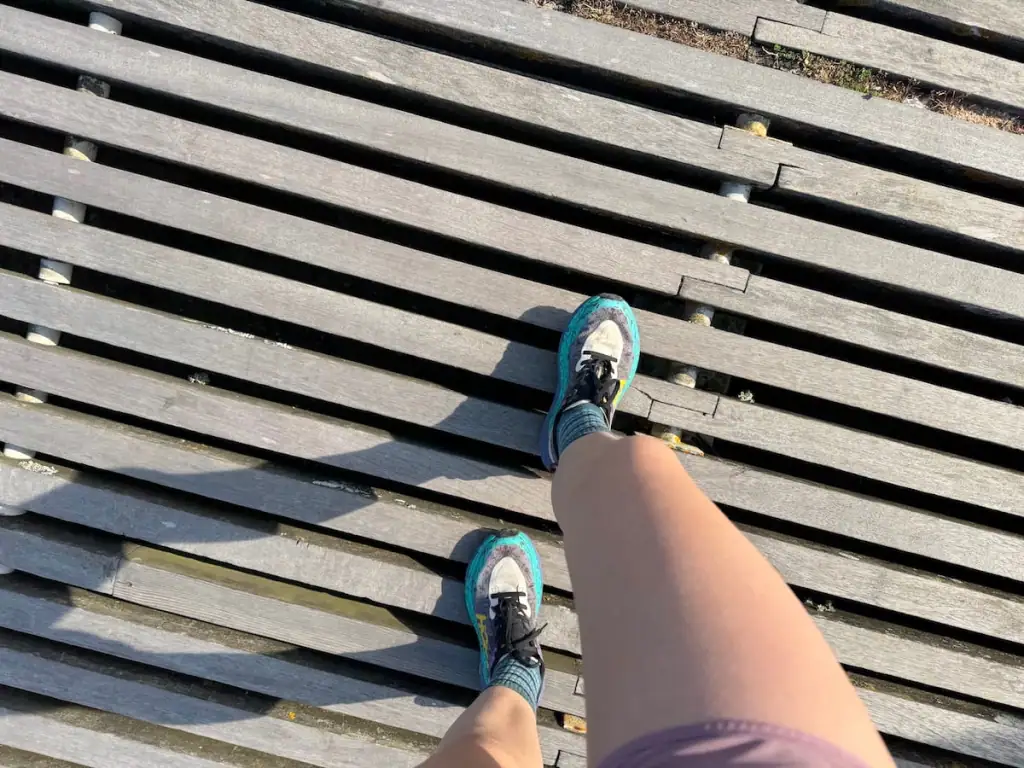
Mistake #5: Buying a Pair of Shoes You Can't Return
A shoe might feel great when you first try it on, but over time as you test it out, it might feel differently. Most stores unfortunately don't allow returns if you've worn a shoe outside, but if you have a store near you that does allow returns, definitely buy your shoes there.
I highly recommend becoming an REI Co-Op Member and purchasing your shoes from them because they allow returns for up to a year, no questions asked.
When I had issues with my first pair of shoes on the Camino Francés, I shipped them back home and returned them later. REI gave me all my money back even though I'd worn them for something like 50 miles (80 km).
If you don't have a store that will take returns for more heavily used shoes, then do your best to wear them for a while around the house, including going up and down stairs. That will help give you a preliminary idea of how your feet like the shoes while still allowing you to likely return them if you have issues.
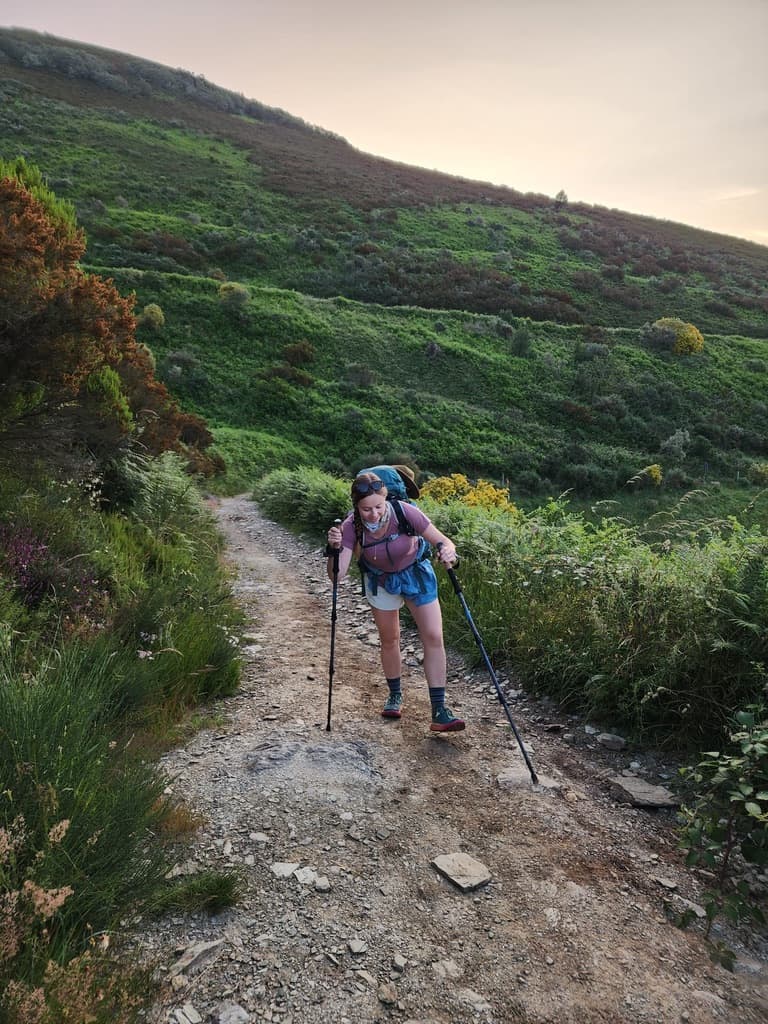
Mistake #6: Only Giving Yourself a Limited Time to Try Out Your Shoes
You want to give yourself more than enough time to try out your shoes because if you have issues with your first pair, then you want enough time to find something else and then break those in.
Thankfully trail runners don't generally require the lengthy period of time that hiking boots need to be broken in. Many are wearable straight out of the box.
However, if you've never tried that particular pair of shoes before, I highly recommend trying them out around your house for a while and on several long hikes if possible to see how your foot responds.
I recommend giving yourself a couple of months to test out shoes before your Camino if you can. That way you aren't rushing and have plenty of time to try multiple pairs of shoes if needed.
Tip: Trail shoes can be pretty pricey. If you want to save money, look for older models of the shoe that might still be available. They're typically a much lower cost than buying the latest model.
Other Essential Shoes for the Camino
Aside from trail running shoes that you wear to walk in each day, I always advise other pilgrims to carry a couple other pairs of shoes with you as well:
- Hiking sandals: These are great as a backup walking shoe if you have issues with your main shoes. They're also good for wearing in town after you arrive at your destination each day since they allow your feet to breathe while providing good support.
- Shower shoes: You should avoid wearing your street shoes in the shower as they can make it quite dirty for the next person using it. Many accommodations also don't like pilgrims to wear street shoes around, so it's good to have a pair of light flip flops for this purpose.

Best Sandals for the Camino de Santiago
I find Chaco to have the best hiking sandals. Tevas are a popular brand as well, but I've met some people who complained about the limited support from their Tevas.
On all three of my Caminos I've brought Chaco Z/Cloud sandals. On my first Camino, they were a lifesaver when my feet couldn't stand my boots anymore but I was waiting to find a store to buy new shoes.
Chaco Z/Cloud sandals have tread that rivals hiking boots or trail running shoes while allowing your feet to breathe. They're also waterproof so perfect for any visits to the beach or swimming in rivers.
Buy Chaco Hiking Sandals
Check out my go-to hiking sandals for the Camino:
➡️ Buy from REI: Women's ($105.00) | Men's ($105.00)
➡️ Buy from Amazon: Women's ($78.73+) | Men's ($104.95+)
Best Shower Shoes for the Camino de Santiago
You don't have to spend too much time researching shower shoes for the Camino. Any simple flip flop will do. I personally use Havaianas.
➡️ Purchase Havaianas flip flops: Amazon
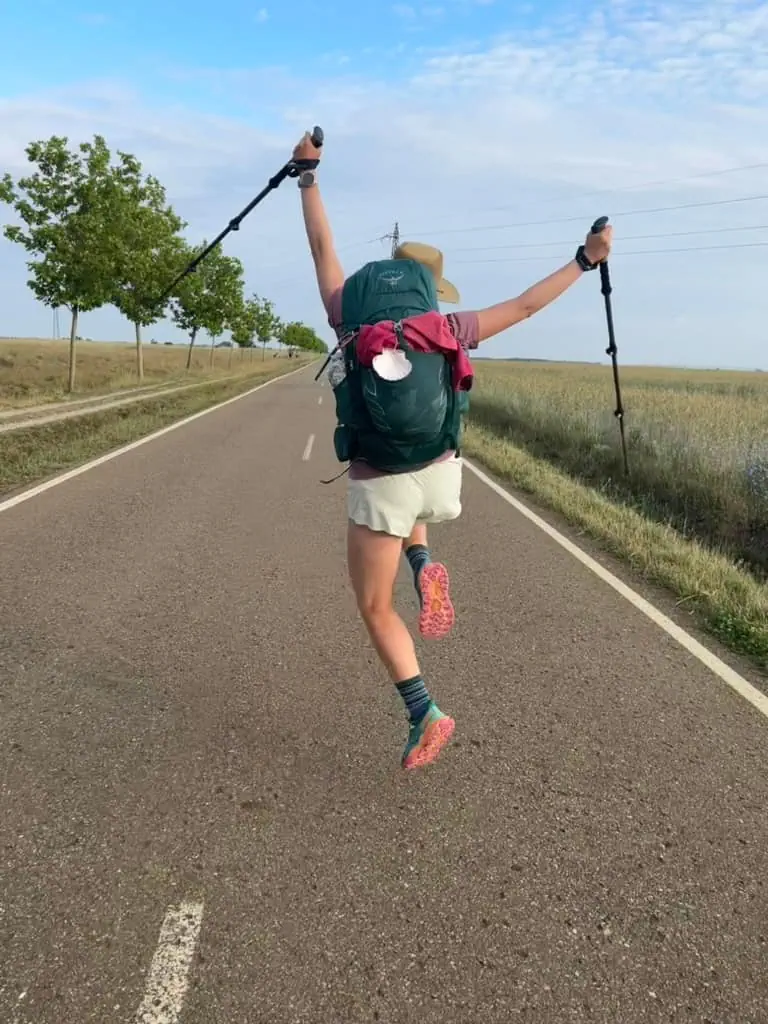
Avoiding Blisters and Dealing with Them on the Camino de Santiago
Sometimes you might have a pair of great shoes but you still, unfortunately, get blisters. Here are my tips to help you avoid them and to deal with them if you get any:
- Consider wearing hiking sock liners as they can help cut down on friction.
- Try rubbing your feet in Vaseline in the morning before putting your hiking socks on. This can help cut down on friction, but note that this could make some people's feet more hot and sweaty.
- Carry blister prevention tape with you to cover your feet in any blister-prone areas.
- Think about switching into a fresh pair of socks in the middle of your walk each day. Minimizing time spent in sweaty socks can help prevent blisters.
- Bring Compeed bandaids with you. These blister bandaids help protect the blister and make it much less painful. Note that you need to keep these on until the bandage starts to come off on its own.
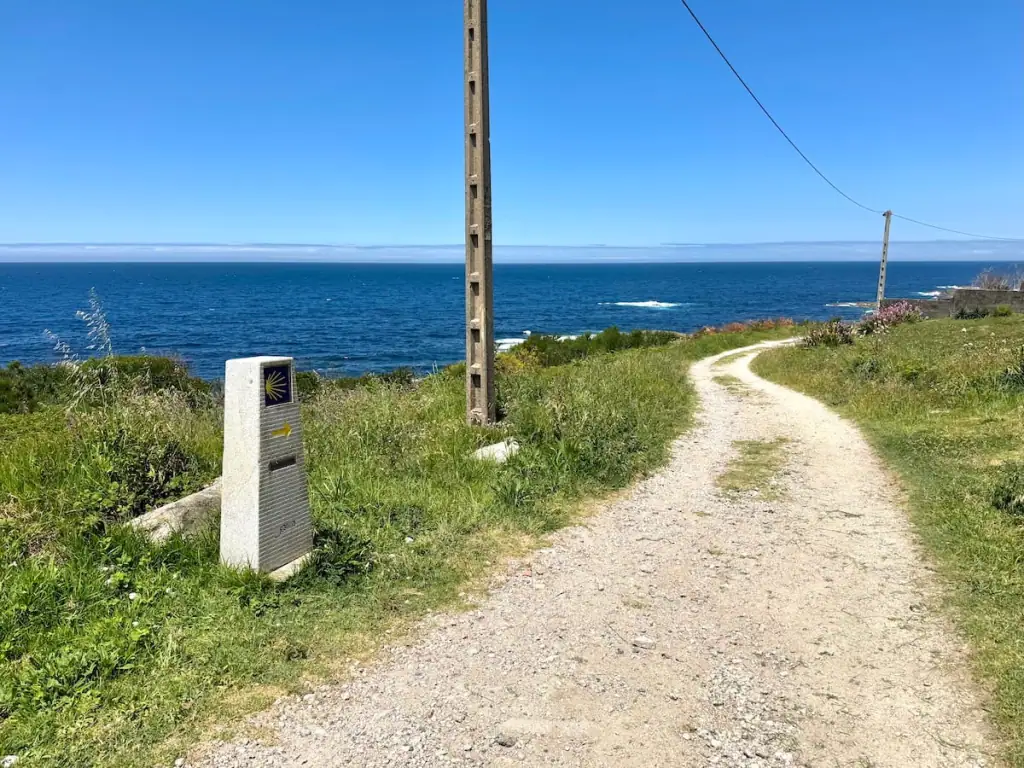
Frequently Asked Questions
Here are some frequently asked questions when it comes to finding the best shoes for the Camino de Santiago and taking care of your feet on the trail.
What is the best shoe for the Camino de Santiago?
The best shoe for the Camino de Santiago can vary from person to person since everyone's feet are different. Trail running shoes are generally the best and popular options include the Hoka Speedgoat, Altra Lone Peak, and Brooks Cascadia.
How many pairs of shoes do you need for the Camino?
Ideally you should carry three pairs of shoes with you on the Camino: a pair of trail running shoes to hike in each day, a pair of hiking sandals to wear in your destination and to use as a backup hiking shoe if needed, and a pair of shower shoes.
How to prepare your feet for the Camino?
To prepare your feet for the Camino, you'll want to start walking as much as you can in advance of your hike. Take it slow and increase mileage slowly over time. As you progress, you'll want to add your pack with some weight and make sure you try out the trail running shoes you plan to wear on the Camino.
What socks to wear on the Camino?
The best socks to wear on the Camino are merino wool hiking socks for their moisture wicking, cushioning, and warmth when wet.
Final Thoughts on the Best Camino Shoes
It can be hard figuring out what the best shoes for the Camino de Santiago are. As you can see, there are truly SO many different shoe options to choose from. I recommend trying out a few different kinds that sound good and seeing which feels the best.
Ultimately we all have different feet and what works best for you may be different than what works best for me.
Get More Details on the Hoka Speedgoat
I wrote a full review on my experience hiking with Hoka Speedgoats on three Caminos. If you're interested in those shoes, I recommend you check that out for more information!
